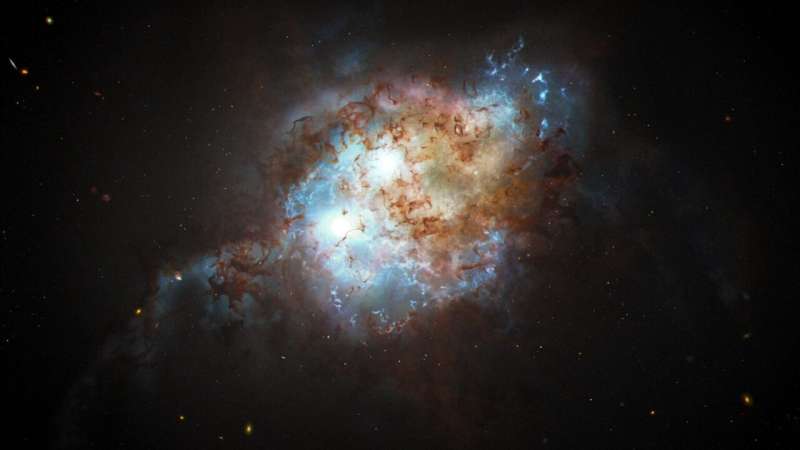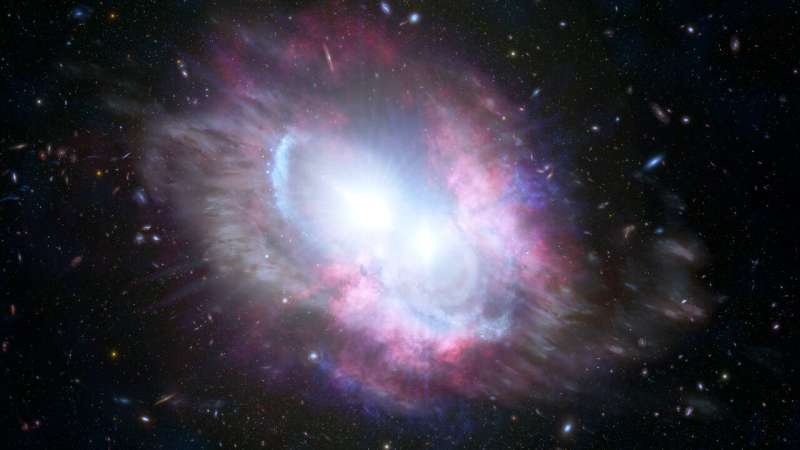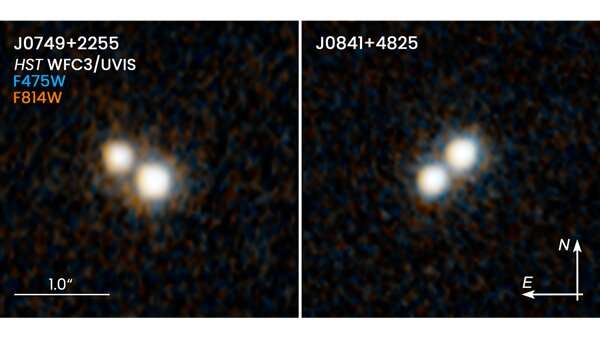This article has been reviewed according to Science X's editorial process and policies. Editors have highlighted the following attributes while ensuring the content's credibility:
fact-checked
peer-reviewed publication
trusted source
proofread
A dual quasar shines light on two supermassive black holes on a collision course inside a galaxy merger

Astronomers have made a rare discovery in the early universe involving two actively feeding supermassive black holes—or quasars—just 10,000 light-years apart from each other, that are on the verge of a colossal collision.
Using a suite of space- and ground-based telescopes, including two Maunakea Observatories in Hawaiʻi—W. M. Keck Observatory and Gemini North—the researchers found the pair of black holes embedded within two galaxies that merged when the universe was just 3 billion years young.
The study, led by the University of Illinois at Urbana-Champaign, is published in today's issue of the journal Nature.
Finding such a system is difficult because of the challenge distinguishing two black holes individually when they are so close together. But in this particular system, called J0749+2255, both black holes were on a feeding frenzy, devouring gas and dust that became heated at such high temperatures, the duo produced a massive fireworks show. This activity is called a quasar, a phenomenon that happens when black holes emit an enormous amount of light across the electromagnetic spectrum as they feast.
J0749+2255 is highly unusual because the system has not one, but two quasars that are active at the same time, and are close enough that they will eventually merge.

"We don't see a lot of double quasars at this early time in the universe. And that's why this discovery is so exciting," said graduate student Yu-Ching Chen of the University of Illinois at Urbana-Champaign, lead author of this study.
ESA's (European Space Agency) Gaia space observatory first detected the unresolved double quasar, capturing images that indicate two closely aligned beacons of light in the young universe. Chen and his team then used NASA's Hubble Space Telescope to verify the points of light were in fact coming from a pair of supermassive black holes.
Multi-wavelength observations followed; using Keck Observatory's second generation Near-Infrared Camera (NIRC2) paired with its adaptive optics system, as well as Gemini North, NASA's Chandra X-ray Observatory, and the Very Large Array network of radio telescopes in New Mexico, the researchers confirmed the double quasar was not two images of the same quasar created by gravitational lensing.
"The confirmation process wasn't easy and we needed an array of telescopes covering the spectrum from X-rays to the radio to finally confirm that this system is indeed a pair of quasars, instead of, say, two images of a gravitationally lensed quasar," said co-author Yue Shen, an astronomer at the University of Illinois.

Because telescopes peer into the distant past, this double quasar no longer exists. Over the intervening 10 billion years, their host galaxies have likely settled into a giant elliptical galaxy, like the ones seen in the local universe today. And the quasars have merged to become a gargantuan, supermassive black hole at its center.
The nearby giant elliptical galaxy, M87, has a monstrous black hole weighing 6.5 billion times the mass of our Sun. Perhaps this black hole grew from one or more galaxy mergers over the past billions of years.
There is increasing evidence that large galaxies are built up through mergers. Smaller systems come together to form bigger systems and ever larger structures. During that process there should be pairs of supermassive black holes formed within the merging galaxies.
"Knowing about the progenitor population of black holes will eventually tell us about the emergence of supermassive black holes in the early universe, and how frequent those mergers could be," said Chen.
"We're starting to unveil this tip of the iceberg of the early binary quasar population," said co-author Xin Liu of the University of Illinois at Urbana-Champaign. "This is the uniqueness of this study. It is actually telling us that this population exists, and now we have a method to identify double quasars that are separated by less than the size of a single galaxy."
More information: Xin Liu, A close quasar pair in a disk–disk galaxy merger at z = 2.17, Nature (2023). DOI: 10.1038/s41586-023-05766-6. www.nature.com/articles/s41586-023-05766-6
Journal information: Nature
Provided by W. M. Keck Observatory




















